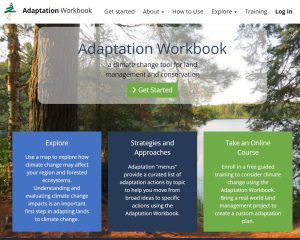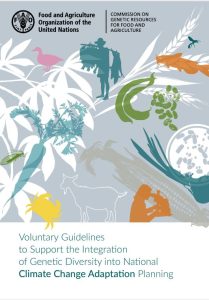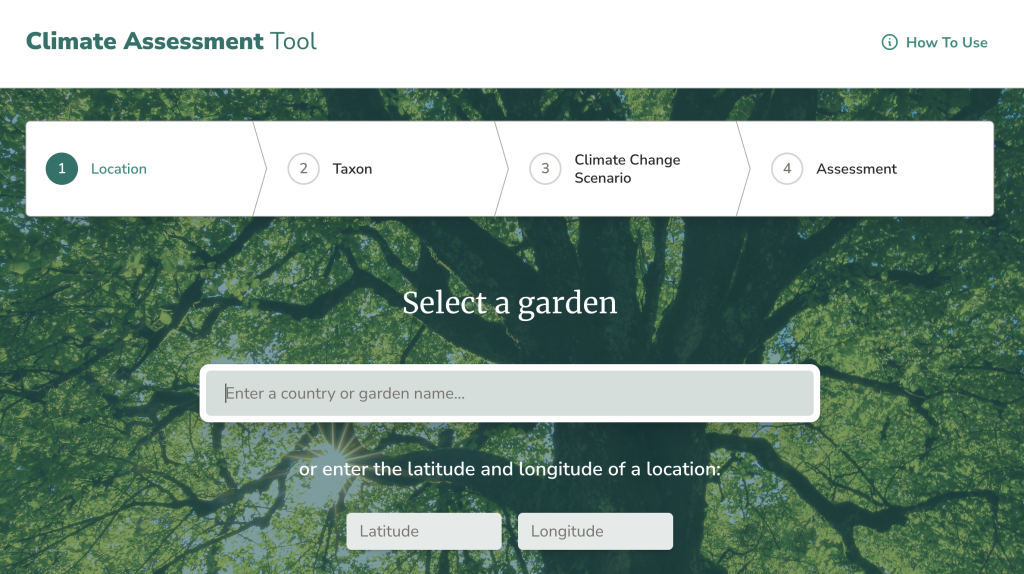Climate adaptation planning for plant collections and conservation
Gayle M. Volk, USDA-ARS National Laboratory for Genetic Resources Preservation, 1111 S. Mason St., Fort Collins, Colorado USA 80521 (Gayle.Volk@usda.gov)
Tara L. Moreau, University of British Columbia Botanical Garden, 804 SW Marine Drive, Vancouver, BC Canada V6T 1Z4 (Tara.Moreau@ubc.ca)
Learning Objectives
Explore how climate adaptation planning can be used to understand and prepare plant collections for a changing climate.
outline
- Introduction
- What is climate adaptation planning?
- Climate adaptation planning frameworks
- Conclusions
- References
- Acknowledgments
1. introduction
Planning and preparation for how climate change could impact plant genetic resource collections and food security is key to plant conservation and the future of agriculture. Forests, parks, gardens, municipalities, branches of the U.S. government, and many other organizations are considering how they are vulnerable to a changing climate. This information, as well as strategies to overcome those vulnerabilities, can be included in implementation plans. The process of assessing vulnerabilities and developing implementation plans is complex, both because a wide range of climatic conditions must be considered and because each organization experiences different risks and possible responses. Localized information and regional climate changes will vary depending on geographic regions and climates. For plant collections managers, risks and adaptation activities will work best when customized to the specific collections and operational systems.
2. what Is climate adaptation planning?
Climate adaptation planning involves understanding potential climate change impacts and vulnerabilities that might impact a given area, in this case, plant collections management. The goal is to identify strategies, approaches, and tactics to protect and maintain plant collections so that plant genetic resources for food and agriculture are secured for current and future generations.
3. Climate Adaptation Planning Frameworks
Planning for climate adaptation is important for making strategic decisions to ensure that ex situ collections are suitable for the future climates. Different climate adaptation planning frameworks exist for land managers, botanic gardens, and climate scientists. Frameworks differ in their process, terminology, data sources, and more. For example, the United States government agencies have publicly released Climate Adaptation Plans. Similarly, the American Public Gardens Association has a website that provides examples of city Climate Adaptation Plans. In 2017, Botanic Gardens Australia & New Zealand and the Climate Change Alliance of Botanic Gardens published its ‘Landscape Succession Strategy’ for climate ready botanic gardens, and in 2022 its associated Toolkit, which supports botanical gardens in considering issues, challenges, and opportunities for effective landscape succession (Entwisle et al., 2017; Climate Change Alliance of Botanic Gardens, 2022a). Access to local and regional climate science information is important in planning for climate adaptation. While frameworks differ in many ways, ultimately planning at the local level will be key and decision-makers can select elements of different frameworks to suit their specific needs. Examples of adaptation frameworks are presented below, showcasing different approaches to adaptation planning.
USDA Climate Adaptation and Resilience Plan
The U.S. Department of Agriculture developed a Climate Adaptation and Resilience Plan (available to download here) framework in 2021 that considers the following ways agriculture is most vulnerable to climate change:
- Decreased agricultural productivity
- Direct impacts: Temperature and precipitation pattern
- Secondary impacts: Disease pressures, pollinator health, decreased quantity and quality, infrastructure, soil quality
- Threats to water quantity and quality
- Disproportionate impacts on vulnerable communities of people
- Shocks due to extreme climate events
- Stress on infrastructure and public lands
Within the USDA adaptation planning framework, some proposed adaptation actions include:
- Build resilience across landscapes with investments in soil and forest health
- Increase outreach and education to promote adoption and application of climate-smart adaptation strategies
- Broaden access to and availability of climate data at regional and local scales for USDA Mission Areas, producers, land managers, and other stakeholders
- Increase support for research and development of climate-smart practices and technologies to inform USDA and help producers and land managers adapt to a changing climate
- Leverage the USDA Climate Hubs as a framework to support USDA Mission Areas in delivering adaptation science, technology, and tools
A 2022 USDA Climate Adaptation and Resilience Plan is available to download here.
USDA Climate Hubs
USDA Climate Hubs are a collaborative network of ten regional United States locations coordinated by the Agricultural Research Service and the Forest Service. They deliver region-specific information relating to climate change decision-making in the United States. The USDA produced a series of short videos to describe the purpose and value of USDA Climate Hubs for the public. Regional climate predictions are critical because they provide recent information that can be used to assess impacts and vulnerabilities for specific regions. Additional climate change response information is available from the U.S. Forest Service at their Climate Change Resource Center. They also provide workbooks and handbooks that serve as a step-by-step guides to develop adaptation plans relating to agricultural and forestry applications.


USDA Climate Hub resources recommend a five step iterative process to develop Climate Adaptation Plans that includes:
- DEFINE management goals and objectives
- ASSESS site-specific climate change impacts and vulnerabilities.
- EVALUATE management objectives given projected impacts and vulnerabilities
- IDENTIFY adaptation strategies, approaches, and tactics for implementation
- MONITOR progress and evaluate effectiveness of implemented actions

These five recommended steps provide a general framework to develop Climate Adaptation Plans. Part of the development process might include revising and reviewing previous steps, including goals and objectives, to ensure the plan addresses project needs (Janowiak et al., 2016).
1. Define management goals and objectives. Determine the scope and location of the effort and also the management goals and objectives. The project timeframe, both with respect to climate predictions and adaptation planning, is also a consideration.
2. Assess site-specific climate change impacts and vulnerabilities. Scientific data and knowledge are consulted to determine the site-specific vulnerabilities that might include the following:
- Rise in sea-level
- Warmer temperatures and extreme heat
- Shorter, warmer winters
- Longer growing seasons
- Increased winter and spring precipitation
- More frequent heavy precipitation events
- Reduced soil moisture or drought
- Increased risk of wildfire
- Altered stream flows
- Changes in plant and/or animal species ranges or assemblages
- Damage from insect pests or pathogens
- Increases in nonnative plant species.
There is a wide range of data available to address these scenarios, much of which is provided through climate models. Some climate projection data are available through WorldClim and Botanic Gardens Conservation International. The USDA has developed “NPGS Climate Futures“, an application that graphically illustrates future climate conditions at sites in the National Plant Germplasm System, which safeguards vast collections of plant genetic resources (Volk et al., 2023). Future climate model predictions have been proposed for several different shared socioeconomic pathways that can be used to predict future conditions. These include: Low greenhouse gas emissions (SSP1-2.6), Intermediate greenhouse gas emissions (SSP2-4.5), High greenhouse gas emissions (SSP3-7.0) and Very high greenhouse gas emissions (SSP5-8.5) (IPCC, 2022).
3. Evaluate management objectives given projected impacts and vulnerabilities. Return to the first step and determine if the original project goals and objectives capture the needs when climate change vulnerabilities are considered.
4. Identify adaptation strategies, approaches and tactics for implementation. Next, identify either broad responses (strategies) or specific responses (approaches) for implementation. The most specific response is called a “tactic”, which gives specific action items. Strategies, approaches, and tactics are considered with respect to the timeframe, benefits, drawbacks, effectiveness, and feasibility (Janowiak et al., 2016). For agriculture and biological systems, complex interactions between soil, water, plants/animals, environment, pests/pathogens, and humans must be considered. Climate adaptation planning workbooks provide a list of strategies, as well as more specific approaches, for consideration, including:
- Sustain fundamental functions of soil and water
- Reduce existing stressors of crops and livestock
- Reduce risks from warmer and drier conditions
- Reduce the risk and long-term impacts of extreme weather
- Manage farms and fields as part of a larger landscape
- Alter management to accommodate expected future conditions
- Alter agricultural systems or lands to new climate conditions
- Alter infrastructure to match new and expected conditions
5. Monitor and evaluate effectiveness of implemented actions. Include methods and timeframes to review progress and determine the effectiveness of the proposed actions. Climate Adaptation Plans are then updated as needed.
European Union Climate-ADAPT project
The European Commission and the European Environment Agency’s Climate-ADAPT project (2022) recommends the following sections for Climate Adaptation Plans:
- Introduction explaining why adaptation is needed, e.g. current and expected climate change impacts
- Consideration of the outcomes of assessment of risks and vulnerable sectors
- Approach in developing the strategy, e.g. cooperation with authorities inside and outside the municipality and other public and private stakeholders
- Aims/objectives of adaptation and strategic directions
- Provisions for monitoring and evaluation and revision of the strategy
- Future outlook


Climate Change Alliance of Botanic Gardens – Landscape Succession for ‘Climate Ready’ Botanic Gardens
The Climate Change Alliance of Botanic Gardens (CCABG) was established in 2018 at the Royal Botanic Garden Victoria in Melbourne, Australia. The CCABG includes over 500 members and aims to support botanic gardens to build strategic responses to climate change. The Landscape Succession Toolkit was one of the first actions of the CCABG and contains content for developing strategies and actions for site-specific adaptation plans. The five strategies outlined (Figure 6) guide the creation of a plan with each strategy also suggesting possible actions.

Emerging tools such as The Climate Assessment Tool (CAT) (Figure 7) provided guidance for botanical gardens to make informed decision about the suitability of trees to predicted future climates of a selected location (Climate Change Alliance of Botanic Gardens, 2022b). Information in this tool comes from datasets of current known occurrences of taxa and compares the current climate of these known occurrences to the predicted climate. By comparing the two climates a suitability score can be generated and decision-makers can use to determine which trees will survive.

4. Conclusions
Climate adaptation planning considers the potential impacts of climatic change and then identifies site-specific actions that can be implemented to increase resilience. Its effectiveness can be monitored, and actions modified accordingly. The assessment of vulnerabilities and inclusion of short-term and long-term needs help provide the information necessary to be proactive with respect to plant collection maintenance. While Climate Adaptation Plan frameworks are built for the unique needs of their users, this chapter highlights a variety of existing frameworks and tools that can inform future Climate Adaptation Plans that support the conservation of important plant genetic resources.
5. references
Climate Change Alliance of Botanic Gardens. 2022a. Landscape Succession for ‘Climate Ready’ Botanic Gardens: A Landscape Succession Toolkit. Available from: rbg.vic.gov.au/initiatives/climate-change-alliance/landscape-succession-toolkit
Climate Change Alliance of Botanic Gardens. 2022b. Climate Assessment Tool v1. Botanic Gardens Conservation International. Richmond, UK. Accessed on 12 May 2022. Available from: cat.bgci.org
Entwisle TJ, Cole C, Symes P. 2017. Adapting the botanical garden landscape of Melbourne Gardens (Royal Botanic Gardens Victoria) in response to climate change. Plant Diversity 39:338-347. DOI: 10.1016/j.pld.2017.11.001
European Climate Adaptation Platform Climate-ADAPT. 2022. Implementing adaptation: Designing an effective adaptation action plan. European Environment Agency. Copenhagen, Denmark. Accessed on 9 Nov 2022. Available from: climate-adapt.eea.europa.eu/en/knowledge/tools/urban-ast/step-5-1
IPCC. 2022. The Intergovernmental Panel on Climate Change. Geneva , Switzerland. Accessed on 2 January 2023. Available from: ipcc.ch
Janowiak MK, Dostie DN, Wilson MA, Kucera MJ, Skinner RH, Hatfield JL, Hollinger D, Swanston CW. 2016. Adaptation resources for agriculture: Responding to climate variability and change in the Midwest and Northeast. USDA Technical Bulletin 1944, Washington, DC. Available from: climatehubs.usda.gov/hubs/northeast/topic/adaptation-resources-agriculture-responding-climate-variability-and-change
USDA. 2021. Action plan for climate adaptation and resilience. US Department of Agriculture. Washington, DC.
Volk GM, Carver D, Irish BM, Marek L, Frances A, Greene S, Khoury CK, Bamberg J, del Rio A, Warburton ML, Bretting PK. 2023. Safeguarding plant genetic resources in the United States during global climate change. Crop Science 1-23. https://doi.org/10.1002/csc2.21003
6. acknowledgments
Citation: Volk GM, Moreau TL. 2023. Climate adaptation planning for plant collections and conservation. In: Volk GM, Moreau TL, Byrne PF. Conserving and Using Climate-Ready Plant Collections. Fort Collins, Colorado: Colorado State University. Date accessed. Available from: https://colostate.pressbooks.pub/climatereadyplantcollections/chapter/climate-adaptation-planning/
This eBook chapter was developed through a collaboration among USDA-Agricultural Research Service, Colorado State University, and the University of British Columbia Botanic Garden, with additional funding from the USDA-NIFA-Higher Education Challenge Grant (2020-70003-303930).
Editor: Katheryn Chen
the organs and tissues (seeds, fruits, cuttings, pollen, tissue cultures, etc.) by which plants can be propagated (synonymous with plant germplasm)
in a climate change context, taking action to prepare for and adjust to both the current and projected impacts of climate change
conservation of plant genetic resources outside their natural habitat

